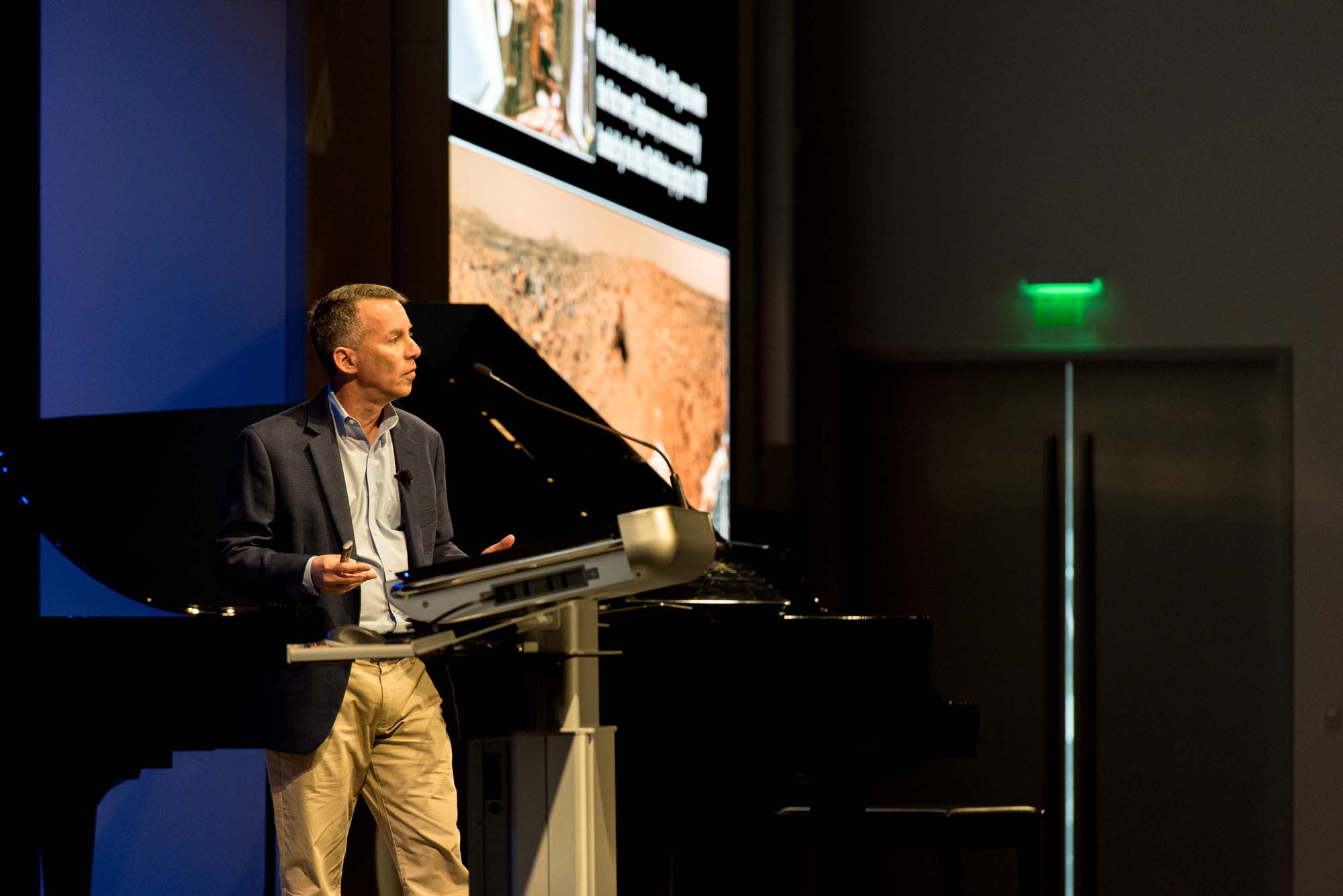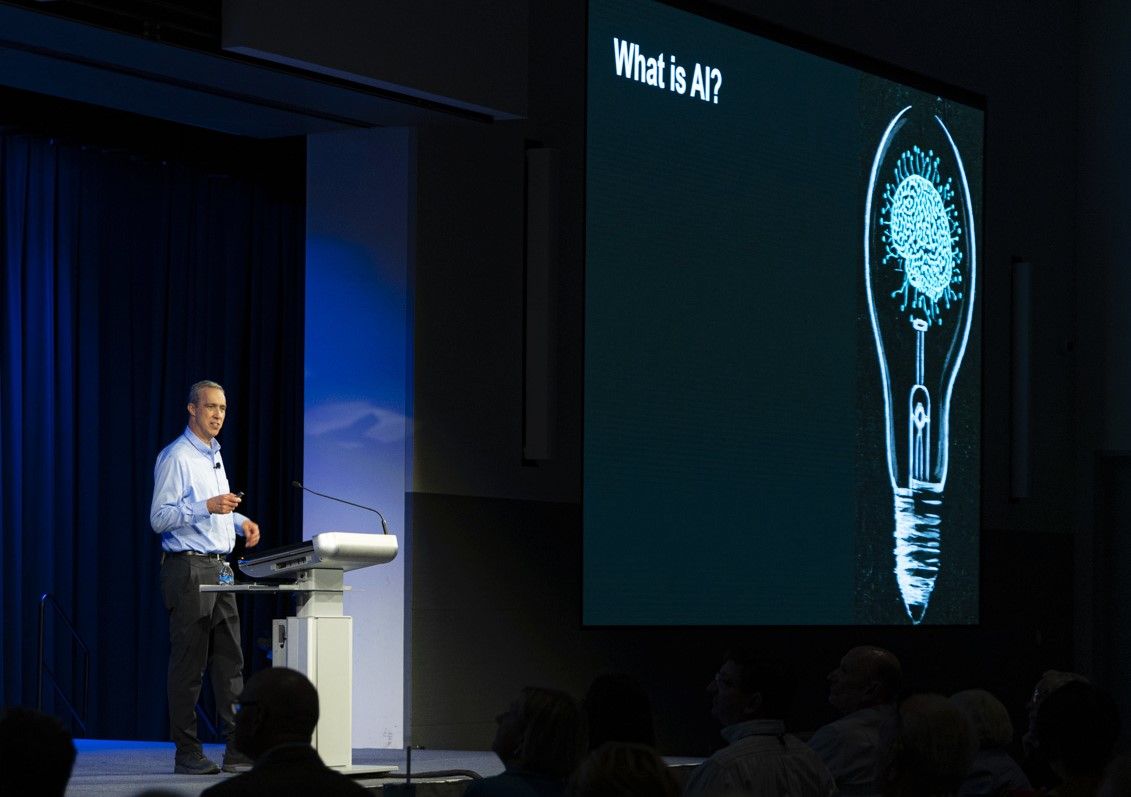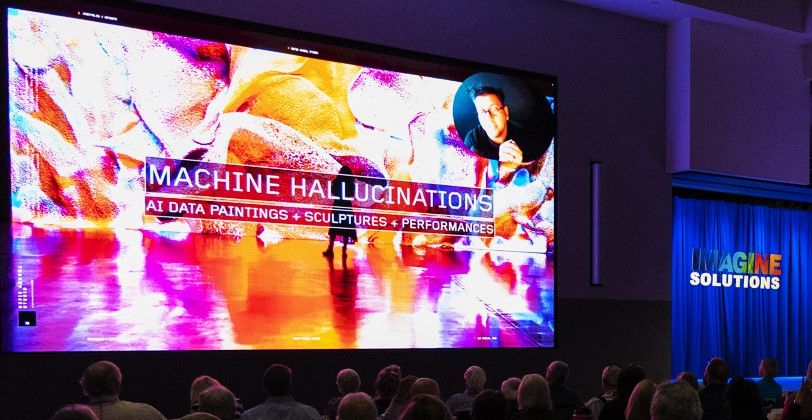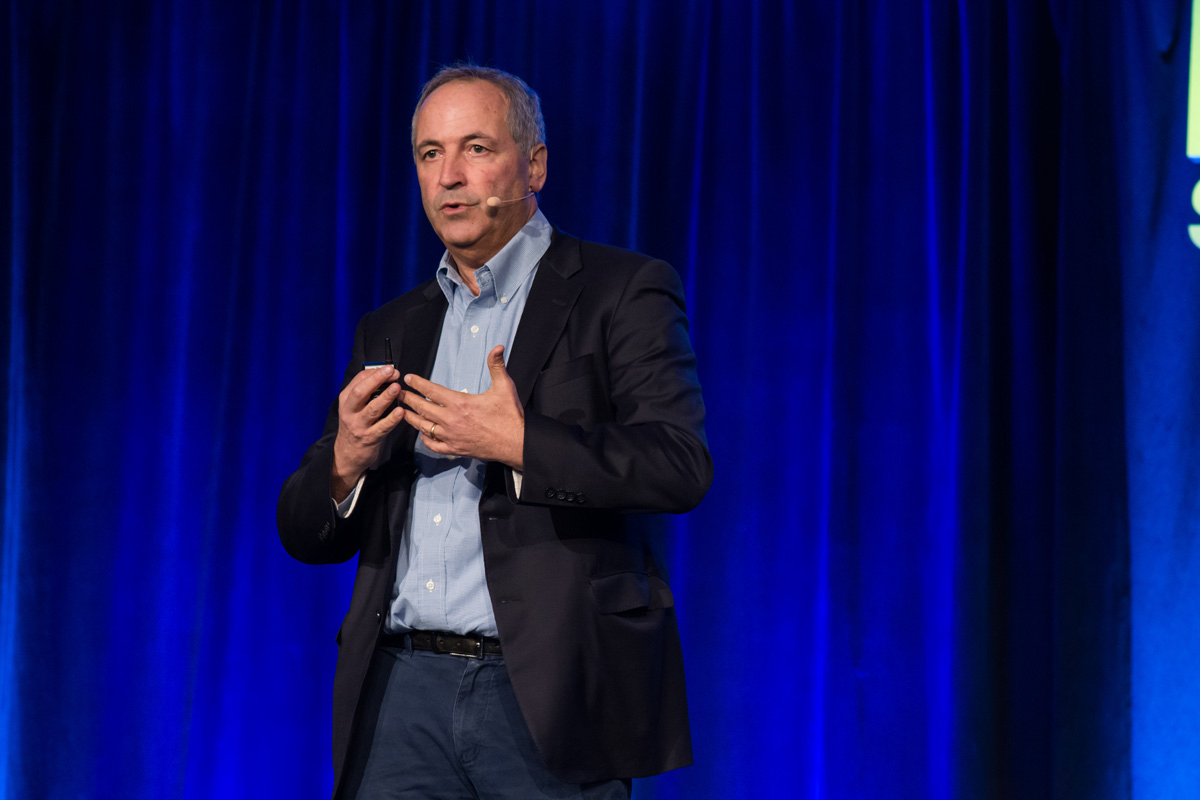Breakthroughs in Science & Technology – Robert Braun
Robert D. Braun, PH.D., Director for Planetary Science of the Mars Exploration Project at NASA’s Jet Propulsion Lab, is an American aerospace engineer and academic. Dr. Braun has been an innovator/leader for 20 years on the Mars Exploration Program and in January 2020 was named NASA’s Director for Planetary Science with responsibility for planetary science formulation, technology, implementation, and operation activities.
00.26
[Applause] [Music] so [Music] the mars exploration project has changed
01.00
space exploration totally the team at nasa created the rocket technology to travel 330 million miles in outer space over eight months and then land on mars a planet with little or no gravity and basically no atmosphere and then do a series of scientific experiments never before done please welcome to our stage robert bobby braun director of planetary science at the jet propulsion laboratory he is in charge of the nasa mars exploration project bobby welcome wow well good morning everyone it's great to be here with you uh i'm thrilled to uh represent the jet propulsion laboratory and nasa and talk to you a little bit about exploration of mars what we're doing now and what we'll be doing in the future and i want to start a little bit with my own story i was
02.00
very fortunate growing up in the state of maryland and in 1976 many of you may remember the united states landed our first spacecraft on another planet we landed on mars we hoped to do so on july 4th but we landed on july 20th 1976 and that was a mission designed to search for life on the red planet it was a hail mary in the sense that we hadn't explored the surface of mars previously and the viking mission while it looked for life on mars it found nothing and we kind of turned away from mars for a little while now as a young child uh my neighbor brought me in to work with him at the goddard space flight center that day and i remember sitting there near the control room watching these engineers and scientists during the landing jumping up and down and hooting and hollering and you know high fiving like only scientists can you know um and thinking you know boy one day i'd like to do that and sure enough i went off to college
03.00
and i studied engineering i got hired by nasa and i started working on projects to send other spacecraft to mars and as it turned out i was part of a team uh people around the country who sent the very next lander to mars and it was called the the uh sojourn the marsh pathfinder mission that took the sojourner rover to the surface of mars and that's shown on the bottom of this uh slide here the sojourner rover was about this big the size of a little baby it was our first rover on another planet and it set us on a course of scientific exploration of mars that we've been pursuing for the last 20 years in fact the u.s has had a continuous presence robotically at mars ever since and we've learned all kinds of things in the last several decades with orbiter missions with lander missions in fact the u.s has attempted to land on mars since that mars pathfinder
04.01
success eight times and my generation has been a part of all of those landings seven of eight which were successful and through our orbital and landed missions we've learned a lot about the planet's climate it's geology it's biological past we've found evidence of past water we've found habitable zones on mars where life may have existed in the past and we're now set to take all of that scientific exploration and all of that engineering know-how and embark on a new chapter in mars exploration and that's what i want to talk to you about today but before i do i just want to point out the growth in our capabilities over these last couple decades so in this image you see the sojourner rover in the foreground and the spirit and opportunity rovers which came next are the roughly golf cart sized rover to the left of that image and then we have curiosity and
05.00
perseverance which are the big rover to the right of that image and so as we've tried to understand more and more about mars we've had to develop a more significant engineering capability and in fact on the perseverance rover today on the surface of mars we have this emblem that we emplaced on its arm which shows the evolution of our capability in rovers from sojourner through spirit and opportunity to curiosity and perseverance and what we're about to embark upon which is the subject of this talk is the mars sample return campaign and in fact in many ways mars sample return has already begun it's begun with the perseverance mission which is trundling across the mars surface today perseverance is a rover designed to collect just the right samples scientifically selected samples and gather them up for later missions that will gather those samples and bring them all the way back to earth mars sample return will be our
06.02
first round-trip mission uh to mars and so it's a really exciting time uh in mars exploration because we have the perseverance rover on the surface which will be collecting these samples over the next five or six years and at the same time here on the earth we're building the sample retrieval lander and the earth return orbiter that i'll talk to you about in just a moment and the other facilities needed to gather those samples and study them scientifically in the research labs across the entire world when they're returned to earth but let me start with perseverance number one in this road map from left to right it's a great mission itself and i have a video just to bring back uh to you maybe where you were and where the world was on february 18th 2021 when we landed the perseverance rover on mars propulsion go edl please leave we have
07.02
deemed perseverance ready to execute entry descent and landing on her own confirmation of entry interface presidents is currently going 5.3 kilometers per second about 120 kilometers from the surface of mars it will start controlling its path to the landing target parachute has deployed and we are seeing significant deceleration the heat shield has been separated progress now has radar lock on the ground the bachelor has separated skyfam maneuver has started about 20 meters off the surface tango delta nominal touchdown
08.00
confirmed persevered faithfully on the surface of mars ready to begin seeking the damage of past life [Music] [Applause] [Music] [Applause] [Music] [Applause] [Music] so that was a great day boy
09.01
um you know it's funny it was over a year ago and i still uh tear up every time i watched that video because it was my team right it was thousands of people around the world around the country who worked for eight years to make that moment happen and if the rocket science of that moment's not hard enough you know the last year was in the peak of the global pandemic uh before the vaccines right when there was so much uncertainty uh when you know february february 18 2021 was maybe the peak of the darkness if you will in our world and one of the things that uh that moment reminds me of is not just the scientific pursuits and the scientific exploration uh but just how we were able to shine a light for the world when the world needed a little bit of hope nasa was there and we all celebrated not just those of us on the mission but the world celebrated with us we were the front page of all the newspapers
10.02
cities all across the globe lit themselves up in red in celebration president biden called moments after the landing to congratulate our team he watched it live just like the rest of the world one of the greatest things about nasa is we broadcast everything live success or failure you're seeing it at the same time that we are and it was just a remarkable day now i want to talk to you a little bit more about that day and in particular i want to tell you that we landed in a place called jezreel crater which is scientifically a treasure trove but it's super dangerous it's a really hard place to land in fact on this image here it's a map from above and then a close-up on the right of where we landed and the red areas are areas that we call death areas where we did not want to land the rover and this is a place where we never would have sent a rover before but we had perfected a technology called terrain relative navigation
11.00
which is a technique to actually as you're descending towards the surface the rover took images of the surface and it mapped those images to the map that it had on board and much like the gps in your car but without gps on mars the rover then flew to those images to a safe spot a safe zone in the middle of the red and where we actually landed is the white dot in the right hand image and you can see that we landed in a super safe place surrounded by less safe places surrounded by death even for the rover and that and death by the way for a landing site usually means interesting stuff scientifically and so that's why we chose to go to this site jezreel crater was for the science and jezreel crater is a phenomenal place it was selected by scientists across the world after studying all the places that we might want to land this particular rover and the reason that we went there is that three and a half to four billion
12.00
years ago it's thought to look like the inset of the image you know in the lower left here we know that water flowed across this surface and three and a half to four billion years ago as when mars was much warmer and wetter than it is today much like the earth in that time and that's the time frame when uh life began to evolve here on the earth and so that's one of the reasons that we're searching here on jezreel and what we're doing as we search across the surface is we're gathering samples this is the first time we've ever had a robotic capability to go up to rocks just like geologists here on earth do in the field themselves and sample those rocks we can extract little cores a little chalk size cores and place them in sealed containers that are each the size of roughly a test tube and then preserve those for the later missions that will bring them back to the earth and so largely that's what perseverance is doing and in september approximately six months ago
13.02
we collected our first rock core at this rock named rochet and we actually sampled it twice that's why you see two holes in the rock and we place those those samples are acquired by a coring drill that places them in a tube and you can see the tubes in the upper left in the upper pictures here in the middle and the left we image those rock cores to make sure the rock's in there and that we know what it looks like and its size and then we seal it as shown in the bottom right of this slide and perseverance has now sealed six rock cores we've also gathered an atmospheric sample and we've sealed a bit of witness material that we brought from the earth with us so today one year into our surface mission we've got eight sealed tubes out of a total of 43 so we've got about 20 percent of the tubes that we're carrying in in this rover with us sealed and ready to come home ready for the rest of the mars sample
14.01
return campaign now perseverance is going to continue across the surface probably for the next at least five years and it's going to go to a whole bunch of exciting vistas in this region it's not just going to sample from the floor of the crater where we are now but it's going to sample from the walls of the rim around us it's going to climb up and explore outside of jezreel crater get some samples there and what we expect to get is somewhere between you know 20 to 40 samples from the entire region and each of these samples is scientifically selected to be precisely what what the scientists would like to study when the samples come back to the earth so it's a remarkable mission and i got to tell you it's going amazingly well i couldn't be prouder of the perseverance team and what they've accomplished now also what's happening uh here on the earth is while perseverance this is showing the overlay of three different missions so the perseverance mission is the mars 2020
15.02
mission in the on the left of this slide and we're currently in partnership with the european space agency uh building two new missions an orbital mission and a lander mission that together we'll go get those samples that perseverance is creating and bring them back to the earth so that we can study them here on the earth for all time much like the apollo samples that the astronauts gathered on the moon that are still in curation at the johnson space center and which we're still gathering scientific insights from so the way marsh sample return is going to work is we're going to send two additional missions and i'm showing the major flight elements for those missions here we have the sample return lander on the left and the sample fetch rover that will be carried by that lander to the surface the fetch rover will get samples that perseverance leaves on the mars surface and bring them back to this lander and then we're going to bring
16.00
along with us the first rocket to mars we're actually going to load those samples in a container that's sealed in the nose of that rocket and then we're going to have our first interplanetary launch in the latter part of this decade where we send the samples up into mars orbit once they're in mars orbit they're going to get picked up by that orbiter that's in the upper right of this image and placed inside an earth entry vehicle and then that orbiter has enough fuel not just to go to mars but to go to mars and come back and it'll position that earth entry vehicle just right so that that earth entry vehicle flies through our own atmosphere and lands in the continental u.s and i have a video that kind of walks you through that i'll talk you through this one as well so this is mars sample return this is the decade that we're in right now this is the chapter of mars exploration that's happening today and as i said it begins with the perseverance rover which i've already talked to you about and has
17.01
already been safely landed on mars is currently driving across the jezreel crater pursuing just the right samples it's going to use its sample caching system and it is using that sample caching system to gather those samples seal them up inside individual tubes and then store those tubes inside the rover itself as it proceeds it'll gather a certain number of tubes that will then place on the mars surface and then it'll continue its exploration gathering more sample tubes we place the ones on the surface for the sample fetch rover to retrieve and then perseverance also has the capability of bringing the samples to the lander the earth orbiter will be launched to mars first it'll go into orbit to support the lander which is launched second this is the sample return lander launch headed towards mars it'll do an entry descent and landing sequence much like perseverances
18.01
using much of the same technology but it in this case it'll have one uh additional feature that i'll talk about in a moment and it's going to land very close to perseverance in fact perseverance will be able to film that landing here's the sample retrieval lander on the surface the sample fetch rover comes off and it picks up the sample tubes off of the surface that perseverance has laid there ahead of time it collects those samples in a tray and brings those samples back to the sample retrieval lander places them in the nose cone of the mars asset vehicle perseverance also will return to the sample retrieval lander bring samples that are stored on board with it back to the sample retrieval lander place those in that same nose cone and then when ready uh the mars ascent vehicle after perseverance delivers those samples the mars ascent vehicle be
19.02
prepped and launched into orbit orbit about mars uh upon achieving orbit that uh nose cone that's sealed uh will release the the sealed container of samples into orbit which will be picked up in an autonomous rendezvous by our orbiter the earth return orbiter once in the earth return orbiter that container is sealed yet again and placed inside the earth entry vehicle the earth entry vehicle is in the top of this image you can see it being manipulated robotically placed in the earth entry vehicle the earth entry vehicle is then sealed multiple times and that bottom half is left at mars because we don't we don't need it anymore it's discarded and then the earth entry the earth
20.01
return orbiter uh then returns to the earth propulsively where the earth entry vehicle is oriented for its flight through earth's atmosphere spun up and released after the nine-month cruise back to the earth here's the release of the earth entry vehicle and it's landing it's a fascinating sequence of events you can see why we would do this nasa and the european space agency together because these three missions are incredibly complex and it's something that you know we want to do as a world frankly on behalf of the scientific community the earth entry vehicle is then recovered uh in this range out in utah and brought to a curation facility where the science actually begins and those
21.01
scientific samples will be allocated to investigators all around the world now the one technology piece that i wanted to mention that's fascinating to me is builds off of that terrain relative navigation that i mentioned before the the technology that allowed us to go to jezreel crater well this time we're going to use terrain relative navigation but we're going to include enough propellant to propulsively maneuver to exactly where we want to go because those samples are already on the mars surface this will be the first time that we're landing to pick up a known quantity in a known location right and so like a delivery truck we want to land right there and we have the technology actually to land within 20 meters of those samples that are pre-placed on the mars surface and so all of these systems all of these engineering systems they actually come together on the surface of mars the sample retrieval lander on the on the right-hand side here with the mars ascent vehicle and its stowed
22.00
configuration the sample fetch rover and perseverance will all meet up on the surface of mars and launch those samples up to see the earth return orbiter now i mentioned this is our first not only is this a scientifically uh compelling and exciting uh mission one that uh scientists around the world have been hoping to do for multiple decades in which we now have the technology and the capability to do but it's also our first round-trip mission to mars and it's going to pave the way frankly for human exploration because i for one don't want to go to mars unless there's a way home as well and well we're talking about rock samples and bringing back a container that's roughly the size of a volleyball much smaller than humans obviously this is a pathfinder for the very large systems that we would need to send humans to mars or to return them safely and so while for the past 25 years we've gone from rovers this big to car-sized
23.00
rovers when we talk about human exploration you know matt damon in the martian for example what we're really talking about doing is landing two-story houses right next to other two-story houses that have been pre-positioned in which fuel and oxygen and food have been generated before the humans get there autonomously think about uh antarctica right that's probably your best uh example of what an early mars base might look like it's a place uh you know where we go scientifically uh often uh today here on the earth and it's a base camp that's been set up over time um and that's the kind of system that would be needed in place uh to send humans to mars in fact uh not only in the martian did you see elements of a base camp but if you saw in other science fiction stories this is from the mars series that was put out by national geographic take a look at all the systems that are needed to keep humans safe on the mars surface
24.02
there's power generation there's propellant for maneuvering there's uh life support uh environments there's food production there's the idea of living on the surface but also maybe subsurface dwelling and you know for radiation protection there's transportation to and from mars it's a pretty complicated endeavor and while it's it's far off in my view everything that we're doing on mars today in our robotic exploration everything that my generation has been doing to to get ready for this is really a handover to the next generation of scientists and engineers and so in summary what i've hoped to tell you today is a few things um first of all mars is a remarkably diverse world every time we go to mars we're surprised not just by what we learn but by new questions that we end up asking ourselves based on what we've seen and we've been exploring while we've been exploring mars for 25 years we're
25.02
now just beginning the next chapter of that saga with the mars sample return campaign and this will be the most complex and most significant robotic exploration undertaking of our lifetime and the only way we're going to be successful is to actually build it off of everything that we've accomplished so far and that mission itself while scientifically exciting will really just be a pathfinder a very small pathfinder for what's required to eventually send humans to mars and to do so we have to continue advance our capabilities so that we as humans can explore mars and elsewhere in deep space thank you very much i appreciate your time and attention if i if i might i'd like to ask bobby a couple of questions i was this sounds like the most complex doordash mission ever yeah i mean you got to go pick up the stuff and deliver it awesome safely but but an engineer's dream engineer's
26.01
dream when the mars um lander is descending you deploy a parachute how does the parachute work in a place where the atmosphere is not as dense as the earth's atmosphere in other words you have resistance of air yeah slowing it down yeah that's a great question so uh we use a supersonic parachute at mars meaning it deploys at uh high speeds right and uh the atmosphere of mars is rough at ground level is roughly equivalent to earth's atmosphere at about a hundred thousand feet and so we actually test our parachute on earth at those altitudes so we we uh either with a balloon or a rocket or both we launch our atmosphere towards space launch our parachute towards space and we deploy it at 100 000 feet on the earth to make sure it works before we do that we test it in ground-based wind tunnels
27.00
and then we make sure it's going to work on mars by testing the way we're going to fly here on the earth we were talking the other night and you i asked you when we when we've tested the soil of mars what's in it and you said there was something that is dangerous in it yeah well maybe that's not the right answer it's not dangerous but well yeah dangerous yeah dangerous for us dangerous for us yeah so this this i don't care about the martians yeah the martians are fine they're fine with it yeah and and our robots are fine with it uh yeah the soil of mars is uh toxic uh for earth type life it's got hexavalent chromium in it chromium that was what it was the uh you know in the martian uh you saw that he had to grow food right and he made his own potato farm that would be pretty hard to do in reality with uh martian soil and so and the other problem you have on mars is there's dust and the dust contains a lot of the same elements of the soil so if
28.00
humans were there they would get dusty when they're outside and then they would come inside and you'd have to clean all that dust off and if you go back and look at the footage of the apollo missions when they were on the moon the whole inside of the apollo capsule got covered in uh lunar dust and so it's it's a very big challenge for human exploration not so much for robotics and then you mentioned even though the temperature on mars is whatever it is you can tell us what it is rigid it's cold you said you could get a real bad sunburn there because well so here on the earth uh we have the van allen belts that protect us from uh the most harmful radiation that's that's headed our way uh mars does not have that mars does not have the van allen ballots and they don't have a global magnetic field uh mars to to shield uh you know life on mars uh from that same environment that's in space would i get a worse sunburn than in naples well it depends how long you're outside
29.03
you can stay inside it either if i stay inside i'm fine you'd be fine bobby thank you very much fantastic thank you you














